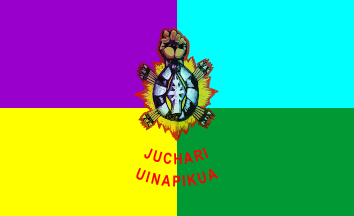
by Juan Manuel Gabino Villascán, emblem from Bandera purépecha, 26 July 2022
1 | 2 | Comuna P'urépecha
Adopted: 17 November 1980

Last modified: 2022-09-10 by juan manuel gabino villascán
Keywords: mexico | tarasco | purepecha | native peoples (mexico) | ethnic flag (mexico) | michoacan |
Links: FOTW homepage |
search |
disclaimer and copyright |
write us |
mirrors

by Juan Manuel Gabino Villascán,
emblem from Bandera purépecha, 26 July 2022
1 |
2 |
Comuna P'urépecha
Adopted: 17 November 1980
A group of Puperechas, moved for the murdering of indigenous people in 1979 in Quiroga, North of Michoacán, when they claimed for their rights to the ranchers, created the Purepecha flag, pursuing a emblem unified all Purepecha towns and, in addition, giving homage to those fallen defending their customs. The flag adoption ceremony was held in the indigenous community of Santa Fe de la Laguna (municipality of Quiroga, Michoacán) on Monday 17 November 1980. The flag is named anaakukua. The flag is a rectangular field, although is could be square as well, divided into four quarters. The first quarter, top hoist, is purple (tsakápundurhu), is for the region of La Ciénaga (The Swamp). The next quarter is blue (japóndarhu), representing the regions of the lakes, core of the ancient Purepecha Empire; though the original is light blue, it is also represented in white. Yellow (eraxaminirhu), bottom hoist, is for the region of La Cañada. Finally, bottom hoist, green (juátarhu), for the Plateau region. In the center of the banner, an obsidian block represents of the god Curicaueri surrounded by solar rays projects its fire to the four cardinal points along with four groups of arrows. The union of the Perepecha people is represented with the white stone knife and a clenched fist. The text bellow "JUCHARI UINAPIKUA", sometimes spelt "JUCHARI UNAPEKUA", means "our strength".
Juan Manuel Gabino Villascán from
Bandera and
Breve reseña, 26 July 2022.
Anything below this line was not added by the editor of this page.